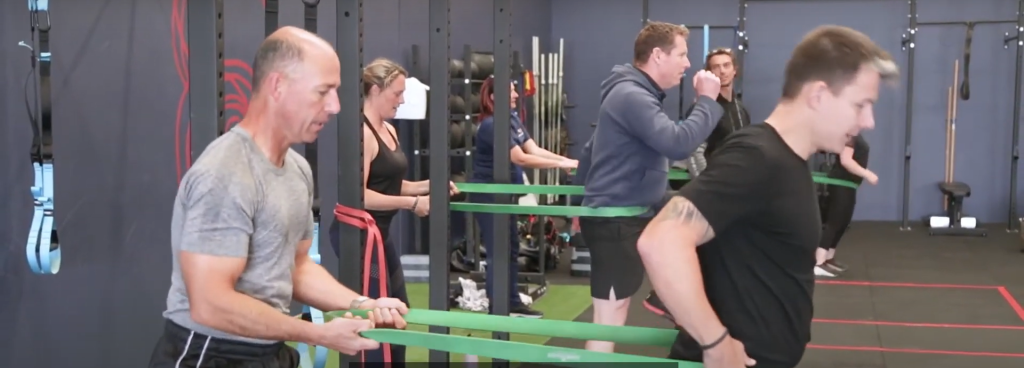Last week we discussed the link between eccentric strength, the stretch shortening cycle and functional training. This week we will look at training methods that develop speed. Speed is often developed with traditional based training modalities such as outdoor sprint training, however, speed can also be developed through the use of resistance based exercises. Effective speed training requires a cyclic interplay between rapid muscle contractions and relaxation (McGill 2009). It is for this reason that many believe traditional strength training limits the development of athletic performance. Consider the example of hitting a tennis ball with a tennis racket, just prior to making contact with the ball, the arm should be fully relaxed throughout the back-swing of the racquet, and then upon impact with the ball, the muscles of the chest, shoulder and arms rapidly contract to create enough stiffness for optimal force transfer, before another cycle of rapid relaxation takes place to allow the player to continue with the follow through phase of the shot. McGill et al.(2012) in his study on the kettlebell swing, reported this exercise contains rapid contraction-relaxation cycles of some muscles occurring over half-second periods, specifically from inactive to 100% activation back to almost complete relaxation. What McGills research shows is how well suited an exercise like the kettlebell swing is, for speed development. In fact the kinetic profile of the kettlebell swing (rapid contraction-relaxation cycles) makes this an ideal exercise selection for many athletes.
Combining the findings of this research with more recent training methods such as “Velocity Based Training” (VBT) may allow the optimal combination of optimal exercise selection and velocity based exercise prescription. VBT utilises high movement velocities to drive neuromuscular adaptations that may lead to increases in speed. In simple terms, VBT can be used to determine the optimal training load for speed development. Consider the following force/velocity graph; if we are trying to develop pure speed, we need to sacrifice some force (or weight) to optimise speed.
Take the example, of an athlete training for a contact sport like judo, they need to be able to lift and throw an equally weighted opponent very quickly, so for this individual, they need a combination of speed and strength (force), making their VBT prescription very different. If they are competing in an 80 kilo weight class, being able to accelerate 80 kilos as quickly as possible, is very important. So over the course of the VBT program we might target a progressive increase in squat, deadlift and press velocity at 80 kilos over time.
VBT requires the use of a linear position transducer (LPT), A LPT is a commercially available device that attaches to a piece of resistance training equipment via a cable or Bluetooth device that provides a measurement of bar or implement speed (measured in meters per second or m/s). These devices can be quite expensive, so to get started you can try getting measures of bar/implement velocity (sand bags or kettlebells) using the “BarSense” or “myJump” Apps, which allows provides a reasonable estimate of bar/implement path and velocity.
One advantage of using the VBRT method is velocity is more stable than % of 1RM, which can vary by as much as 18% (Jidovtseff 2009). In fact, most readers are likely to be familiar with 1RM training zones, used to prescribe resistance training programs to improve strength, hypertrophy or power. More recently however, there has been the development of velocity based training zones (below) which can be used to develop these same qualities, including speed.
Even more interesting is the strong relationship velocity has with the % of 1RM, meaning by using velocity measures, we can also still train non-speed based variables, such as strength and even hypertrophy! In the final analysis, training with velocity feedback increases client engagement in the exercise/program as they can see very tangible results and gain immediate feedback on their performance. Velocity measurement devices are currently quite expensive, however, in time, and with the ever increasing popularity of this training method, the cost of these devices should come down and be more accessible to trainers in the field. Armed with this information and possibly the right technology (try the BarSense app to get started), functional training exercises can now take on a whole training dimension, and focus on VBT to achieve improvements in speed.
References
1. Jovanovic & Flanagan. (2014). Research applications of velocity based strength training. J. Aust. Strength Cond. 22(2)58-69.
2. Jidovtseff et al. (2009). Inertial muscular profiles allow a more accurate training loads definition.24: 91-96
3. McGill SM, Marshall LW. Kettlebell swing, snatch, and bottoms-up carry: back and hip muscle activation, motion, and low back loads. J Strength Cond Res. 2012;26: 16-27.
4. McGill, S.M. (2009) Ultimate back fitness and performance – Fourth Edition, Backfitpro Inc., Waterloo, Canada, (www.backfitpro.com).
5. Morris, B. (2005). Presented at Collegiate Strength & Conditioning Coaches Association, Salt Lake City, UT.
6. Mann B. Velocity Based Training. Accessed: 20th June 2017. From:https://kinetic.com.au
For for Newsletter

